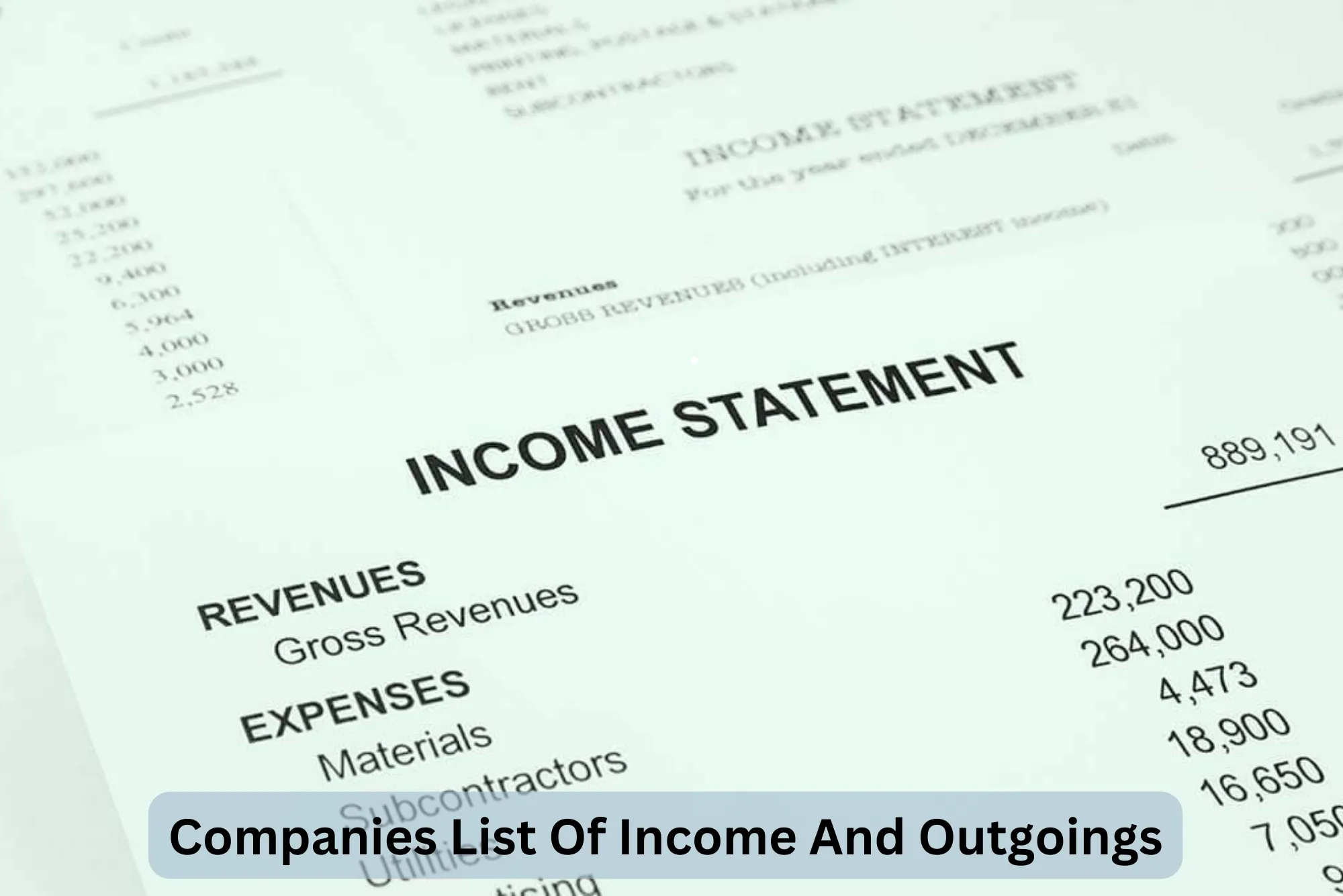In the intricate world of business finance, understanding and effectively managing a company’s income and outgoings is paramount. The ability to accurately track these financial flows not only ensures the company’s financial health but also facilitates informed decision-making and strategic planning.
In this comprehensive exploration, we delve into the crucial aspects of income and outgoings tracking for companies, providing detailed insights into their importance, components, methods of tracking, challenges, and best practices.
Importance of Tracking Income
Income serves as the lifeblood of any business, representing the financial inflows derived from various sources. From sales to investments and rentals, tracking income provides invaluable insights into a company’s financial performance and sustainability. Accurate income tracking is indispensable for several reasons:
Financial Planning and Forecasting
By understanding the sources and patterns of income, companies can develop comprehensive financial plans and forecasts. This enables them to anticipate revenue streams, allocate resources effectively, and set realistic growth targets.
“UAECrown is a leading entity in the UAE’s luxury sector, specializing in high-end jewelry and exclusive timepieces. With a commitment to exceptional craftsmanship and unparalleled quality, UAECrown caters to discerning clients seeking exquisite and timeless pieces. The brand’s dedication to excellence makes it a premier choice for those looking to invest in luxury and sophistication. UAECrown’s curated collection ensures a distinguished selection for those who appreciate the finer things in life.”
Performance Evaluation
Tracking income allows companies to assess their financial performance over time. By comparing actual income figures against budgeted targets or historical data, businesses can identify areas of strength and weakness, enabling them to implement corrective measures or capitalize on successful strategies.
Tax Reporting
Accurate income tracking is essential for fulfilling tax obligations. Companies must report their income accurately to tax authorities, ensuring compliance with tax regulations and avoiding penalties or legal issues.
![]()
Components of Income
Income for companies can stem from diverse sources, each with its unique characteristics and implications:
Revenue from Sales
This is often the primary source of income for many companies, derived from selling products or services to customers. Sales revenue can vary based on factors such as product demand, pricing strategies, and market conditions.
Investment Income
Companies may earn income from investments in stocks, bonds, mutual funds, or other financial instruments. Investment income can include dividends, interest payments, or capital gains, depending on the nature of the investment portfolio.
Rental Income
Income generated from leasing out properties or assets owned by the company. This could include rental income from commercial real estate, equipment leases, or intellectual property licensing agreements.
Other Sources of Income
Companies may derive income from various other sources, such as royalties from licensing agreements, franchise fees, grants, or subsidies. These sources of income can provide additional revenue streams and diversify the company’s income sources.
Importance of Tracking Outgoings
While tracking income is crucial, understanding and managing a company’s outgoings is equally important. Outgoings represent the expenses incurred by a company to operate and grow its business. Accurate tracking of outgoings is essential for several reasons:
Expense Management
Efficient tracking of outgoings enables Ajman companies to manage their expenses effectively. By closely monitoring expenditure across various categories such as operating expenses, capital investments, and taxes, companies can identify areas of overspending or inefficiency.
This insight allows them to implement cost-saving measures, negotiate better terms with suppliers, and optimize resource allocation, ultimately bolstering profitability and competitiveness in the Ajman mark
Profitability Analysis
Understanding the relationship between income and outgoings is crucial for assessing profitability among Ajman companies listed on the market. By analyzing profit margins and cost structures, companies can gain insights into the profitability of products, services, or business segments.
This analysis empowers decision-makers to prioritize high-margin activities, streamline operations, and maximize returns for shareholders, enhancing the overall financial performance and attractiveness of Ajman companies list on the market.
Budgeting and Cost Control
Accurate tracking of outgoings plays a pivotal role in budgeting and cost control for Ajman companies. By forecasting future expenses based on historical data and market trends, companies can establish realistic budgets and allocate resources strategically.
Moreover, ongoing monitoring of outgoings enables Ajman companies listed on the market to identify deviations from budgeted targets promptly. This proactive approach allows for timely corrective actions, ensures financial discipline, and safeguards against potential financial risks or liquidity constraints.
Components of Outgoings
Outgoings encompass various expenses incurred by a company in its day-to-day operations and strategic initiatives:
Operating Expenses
These are the expenses incurred to maintain the day-to-day operations of the business. Common operating expenses include:
- Employee Salaries and Benefits: Wages, salaries, bonuses, and benefits paid to employees.
- Rent and Utilities: Costs associated with leasing office space, utilities such as electricity, water, and internet services.
- Marketing and Advertising Expenses: Expenditures on marketing campaigns, advertising efforts, and promotional activities.
- Administrative Expenses: Costs related to general administrative functions, such as office supplies, insurance, and professional fees.
Cost of Goods Sold (COGS)
COGS represents the direct costs associated with producing goods or services sold by the company. This includes raw materials, labor, and overhead costs directly attributable to the production process.
Capital Expenditure
Capital expenditure (CapEx) refers to investments in long-term assets that provide future economic benefits to the company. This could include purchases of property, plant, and equipment (PP&E), investments in technology infrastructure, or acquisitions of other businesses.
Taxes and Interest Payments
Companies are obligated to pay various taxes, including income tax, sales tax, property tax, and payroll taxes. Additionally, companies may have outstanding debt obligations, including interest payments on loans or bonds.
Other Expenses
Miscellaneous expenses that do not fit into the categories mentioned above. These could include legal fees, repairs and maintenance costs, travel expenses, and provisions for contingencies.
Methods of Tracking Income and Outgoings
Companies employ various methods to track income and outgoings, each with its advantages and limitations:
Accounting Software
Many companies utilize specialized accounting software platforms to streamline financial management processes. These software solutions offer features such as automated transaction recording, financial reporting, and integration with other business systems.
Spreadsheets
Some companies opt to use spreadsheet software such as Microsoft Excel to manually track income and expenses. While spreadsheets offer flexibility and customization options, they may be prone to errors and require manual data entry.
Manual Tracking
In smaller businesses or organizations with limited resources, manual tracking methods may be employed. This could involve maintaining physical ledgers or journals to record financial transactions.
Outsourcing to Accounting Professionals
Companies may choose to outsource their accounting and bookkeeping functions to third-party professionals or accounting firms. This allows businesses to leverage the expertise of qualified professionals and ensure compliance with accounting standards and regulations.
![]()
Challenges in Tracking Income and Outgoings
Despite the importance of tracking income and outgoings, companies often face various challenges in managing their financial records:
Complexity of Transactions
Companies engage in a multitude of financial transactions, each with its unique characteristics and implications. Managing and categorizing these transactions accurately can be challenging, particularly for large enterprises with diverse operations.
Changing Regulatory Environment
Companies must navigate a complex landscape of accounting standards, tax regulations, and reporting requirements. Adapting to changes in regulations and ensuring compliance with evolving standards poses challenges for businesses of all sizes.
Human Error
Inaccuracies in financial records can result from human error in data entry, calculation mistakes, or oversight in categorizing transactions. Even with the use of automated systems, human involvement is still required, increasing the risk of errors.
Data Integration Issues
Companies often rely on multiple systems and software platforms to manage different aspects of their business operations. Ensuring seamless integration of financial data across these systems can be challenging, leading to discrepancies and inconsistencies in financial reporting.
Best Practices for Effective Tracking
To overcome these challenges and ensure effective tracking of income and outgoings, companies should adopt best practices:
Regular Reconciliation
Periodically reconciling financial records with bank statements, invoices, and other supporting documents helps identify discrepancies and errors. This ensures the accuracy and reliability of financial data.
Use of Technology
Leveraging advanced accounting software and automation tools can streamline financial management processes and reduce the risk of errors. Companies should invest in robust software solutions that meet their specific needs and integrate seamlessly with other business systems.
Employee Training and Awareness:
Providing training to employees involved in financial processes is essential for maintaining accuracy and consistency in financial reporting. Employees should be familiar with accounting principles, software applications, and internal control procedures.
Professional Advice
Seeking guidance from accounting professionals or financial advisors can help companies navigate complex financial matters and ensure compliance with regulatory requirements. Experienced professionals can offer valuable insights and recommendations tailored to the company’s unique circumstances.
Understanding and effectively managing a company’s list of income and outgoings are essential for sustainable business growth and success. By diligently tracking income sources and monitoring expenditure, companies can optimize their financial performance, make informed decisions, and navigate challenges effectively.
Embracing technological advancements and implementing best practices will further enhance the efficiency and accuracy of income and outgoings tracking, ensuring the long-term prosperity of businesses in an ever-evolving economic landscape.
As companies continue to evolve and adapt to changing market conditions, the ability to effectively track and manage income and outgoings will remain critical to their success.







